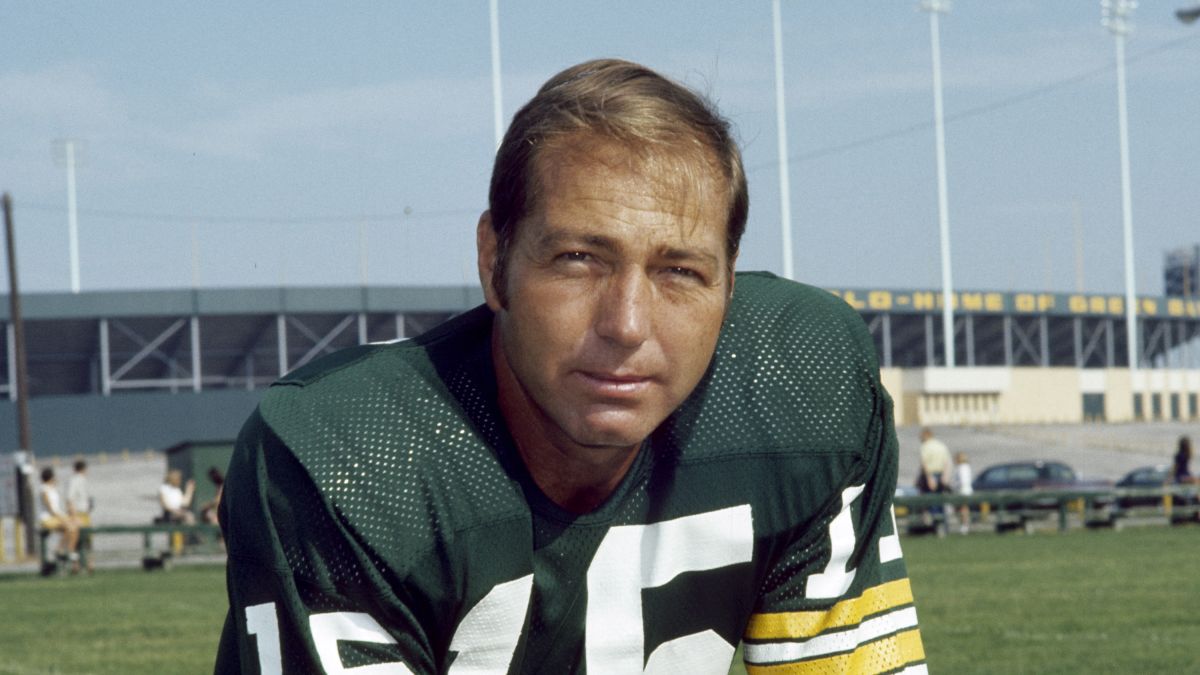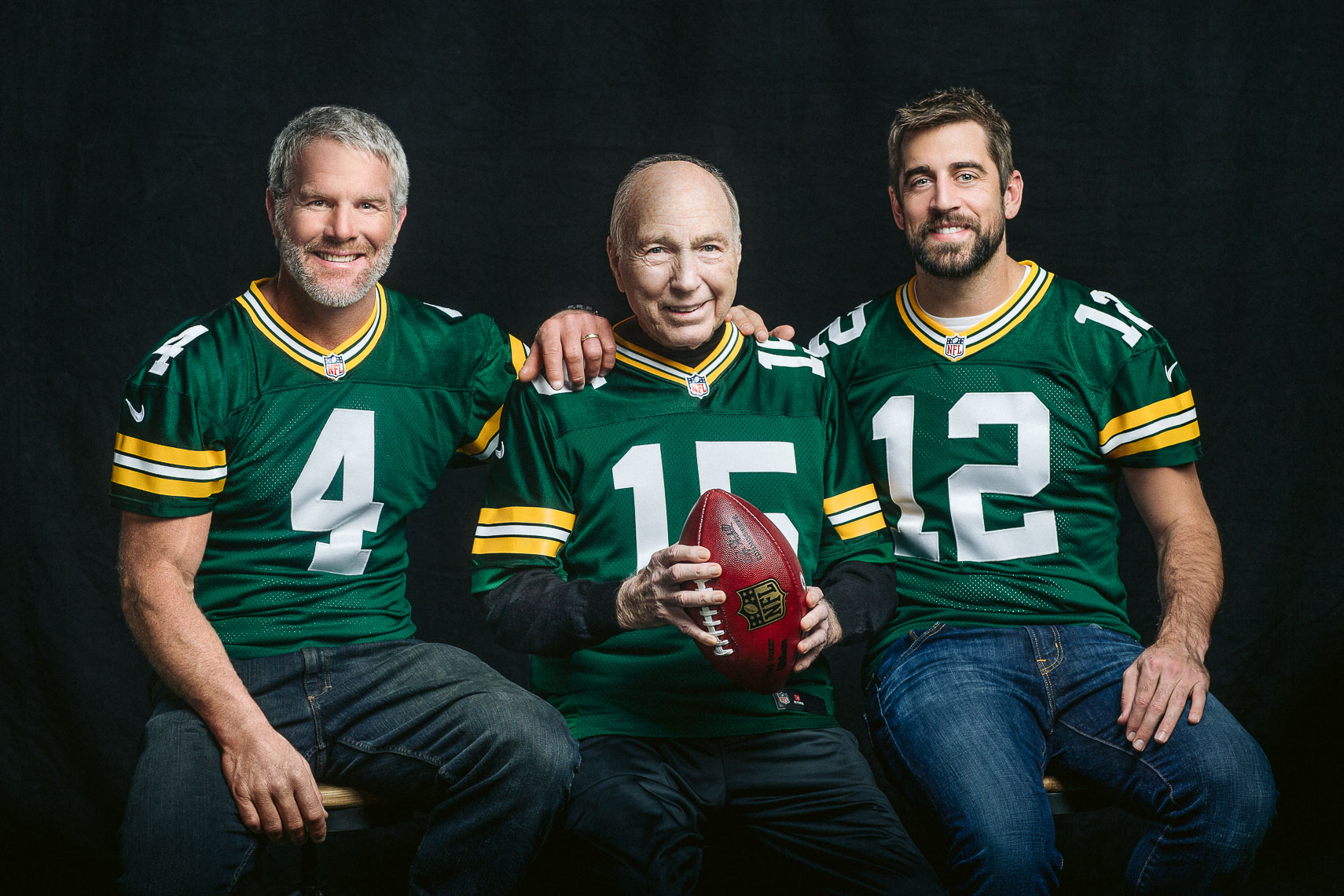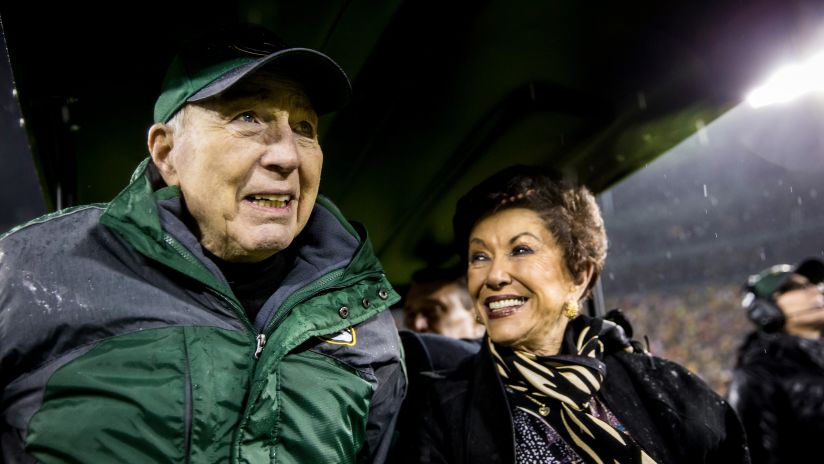Bryan Bartlett Starr was born on January 9, 1934 in Montgomery, Alabama. He had a difficult relationship with his father. He quit the football team at Sidney Lanier High School in Montgomery 2 weeks into his sophomore year. His father told him he could play football, or he could drop out of high school and work in the family garden. Bart went back to football.
In his junior year, he led Lanier to an undefeated season. He went to the University of Alabama -- before Bear Bryant became its head coach. At the time, the Southeastern Conference allowed freshmen to play varsity football, and Starr played enough to earn a varsity letter, even throwing a touchdown pass in the 1953 Orange Bowl -- which was completely unnecessary, as Alabama inundated Syracuse 61-6.
He became the starter the next year, and got Alabama into the 1954 Cotton Bowl, where they lost to Rice, in a game remembered for Rice being awarded a touchdown when Alabama's Tommy Lewis jumped off the bench, becoming an ineligible player, and tackled Dickey Moegle to prevent him from scoring a touchdown.
In the off-season, Starr eloped with his girlfriend, Cherry Morton -- an Auburn student. The fact that she went to 'Bama's arch-rival wasn't nearly as much of a problem as their marriage happening at all: In those days, colleges often revoked the scholarships of married athletes. So they kept it a secret, and Bart stayed in Tuscaloosa the University, while Cherry returned to her hometown of Jackson, Alabama.
A few weeks later, he suffered a back injury, which nagged him for the rest of his life, but also made him 4-F and ineligible for the military draft. A new coach, J.B. Whitworth, went with a youth movement, and benched Starr, resulting in poor seasons that led to Whtiworth's firing and Bryant's hiring.
*
Starr's chances of a pro career seemed over: No NFL team seemed likely to draft him, and the AFL wasn't even an idea at this point. But Alabama basketball coach Johnny Dee was a friend of Jack Vainisi, the personnel director of the Green Bay Packers. Vainisi drafted Starr in the 17th Round of the 1956 NFL Draft.
These are the quarterbacks who were selected ahead of Starr in that draft: Earl Morrall of Michigan State, by the San Francisco 49ers; John Roach of Southern Methodist, by the Chicago Cardinals; Jerry Reichow of Iowa, by the Detroit Lions; Em Lindebeck of Illinois, by the Los Angeles Rams; John Polzer of Virginia, by the Baltimore Colts; Tom Spiers of Arkansas State, by the Cardinals; George Herring of Mississippi Southern, by the 49ers; and George Welsh of the Naval Academy, by the Cardinals. Of these, only Morrall had much of a pro career, although Welsh went on to be elected to the College Football Hall of Fame as a coach, winning 2 Atlantic Coast Conference titles at Virginia. (He died earlier this year, age 85.)
In Starr's 1st 3 seasons, he split playing time, first with Tobin Rote, then with Babe Parilli -- both of whom would become bigger stars in the AFL. The Packers were terrible, bottoming out at 1-10-1 in 1958.
In 1959, they hired Vince Lombardi as head coach. Lombardi had 2 messages for his players: "We may not win, but we won't be losing with the same people"; and, "Those who stay will be champions." He cleared out the talented underperformers, showing everyone else that no one's job was safe if they didn't work hard enough and smart enough.
Starr worked hard and smart, and Lombardi loved him for it. And Lombardi built an offense for Starr to work with, including Hall-of-Fame running backs Paul Hornung and Jim Taylor, and Hall-of-Fame linemen Jim Ringo, Jerry Kramer and Forrest Gregg; and a great defense that included Hall-of-Famers Willie Davis, Henry Jordan, Ray Nitschke, Herb Adderley and Willie Wood.
Together, they would dominate the NFL in the 1960s. In 1959, they improved to 7-5. In 1960, they won the NFL Eastern Division, losing the NFL Championship Game to the Philadelphia Eagles. In 1961, they won the NFL Championship. In 1962, they did it again. Both times, they defeated the New York Giants in the title game. After missing the Division title in 1963 and 1964, they won 3 straight NFL Championships Games -- the only time it's ever been done -- against the Cleveland Browns in 1965, and the Dallas Cowboys in 1966 and 1967.
Starr and Lombardi
Along the way, in a league that then included Johnny Unitas of the Baltimore Colts, Sonny Jurgensen of the Philadelphia Eagles and then the Washington Redskins, Y.A. Tittle of the Giants, and Fran Tarkenton of the Minnesota Vikings, Starr led the NFL in passer rating 5 times, made 4 Pro Bowls, and was named NFL Most Valuable Player for the 1966 season. He wasn't just a guy benefiting from being on a great team: He directed that great team. Lombardi may be thought of today as a "micromanager," but he let Starr call his own plays.
Nowhere was that more important than at the end of the 1967 NFL Championship Game, at Lambeau Field in Green Bay, a game so cold it was known as the Ice Bowl. The Packers trailed the Cowboys 17-14 with 16 seconds left, and had a 3rd-and-goal on the 1-yard line. Run the ball and fail, and they wouldn't be able to stop the clock in time to kick the tying field goal. Pass the ball, and it could fall incomplete, leaving 4th down with the clock stopped with a few seconds left, and you could still kick the field goal -- but it could also be intercepted. Kick it now, on 3rd down, and it could be missed, and even if it's made, the game is still only tied.
Starr recommended a play called "31-Wedge" to Lombardi: "Coach, the linemen can get their footing on the wedge, but the backs are slipping. I'm right there. I can just shuffle my feet and lunge in."
At this point, Lombardi was as cold and as tired as anyone, and was not looking forward to overtime, so he told Starr, "Run it, and let's get the hell out of here!"
Starr called the play. It required guard Kramer and center Ken Bowman to double-team Cowboys defensive tackle Jethro Pugh. Bowman snapped the ball, Starr took it, lowered his head, and followed the block. Touchdown. Packers win, 21-17.
This is Walter Iooss Jr.'s photo for Sports Illustrated.
The most familiar shot of the touchdown is in black & white,
and I wanted a color photo.
In his 1980 book Pro Football's 10 Greatest Games, sports historian (usually specializing in baseball) John Thorn wrote, "It is the most famous touchdown in football history." This was before the 1982 Dwight Clark "The Catch," but Thorn put it ahead of the 1958 Alan Ameche overtime score (he included that title game in the book), and the 1974 Clarence Davis "Sea of Hands" catch (he included that game, too), and apparently ahead of the 1972 Franco Harris "Immaculate Reception" (he did not include that game).
Bart Starr quarterbacked 5 NFL Championships. To this day, no other man has ever done that, except Tom Brady, and he doesn't count. Can you imagine Vince Lombardi putting up with his quarterback -- or, as general manager, with his head coach -- cheating? No you can't. Don't even try. Maybe Brady would have won a title or two with Lombardi running things, but it would have been honestly. Not the 5 that Starr won, or the 6 that Brady has won, all of them questionable.
The 1966 and 1967 seasons were the 1st 2 in which the Champions of the 2 Leagues would face each other, in what was then named "The AFL-NFL World Championship Game." It would begin to be officially called the Super Bowl for the 3rd one, and the Roman numerals were added 2 years after that, for Super Bowl V. So the title games played on January 15, 1967 and January 14, 1968 were retroactively renamed "Super Bowl I" and "Super Bowl II."
In Super Bowl I, at the Los Angeles Memorial Coliseum, Starr completed 16 of 23 passes, for 250 yards, 2 touchdowns and an interception. The Packers beat the Kansas City Chiefs 35-10. In Super Bowl II, at the Orange Bowl in Miami, Starr completed 13 of 24, for 202 yards, a touchdown, and no interceptions. The Packers beat the Oakland Raiders 33-14.
Both times, Starr was named the game's MVP. The award was presented by the now-defunct SPORT magazine, and the prize was a new Chevrolet Corvette. Starr donated his Super Bowl II Corvette to Rawhide Boys Ranch in New London, Wisconsin, which he had co-founded to help troubled boys in Wisconsin.
But Super Bowl II was Lombardi's last game with the Packers. The dynasty players were getting old, and Lombardi's successors on the sideline and in the front office were not up to the task. Starr retired during training camp in 1972, at age 38.
*
He immediately went into coaching, becoming the Packers' quarterbacks coach, under head coach Dan Devine. In 1972, with Starr advising Scott Hunter, the Packers won the NFC Central Division. Then he left football, to pursue private business interest, and broadcast some games for CBS.
After the 1974 season, Devine was hired by Notre Dame -- interestingly, the alma mater of Packers founder Earl "Curly" Lambeau -- and Starr was hired. He only made the Playoffs once, in 1982, and got them to a Playoff win over the St. Louis Cardinals, before losing to the Dallas Cowboys. He was fired after the next season.
Almost immediately, a group looking to gain an expansion team for Phoenix, hired Starr to coach the team they wanted to call the Arizona Firebirds. But the NFL put expansion plans on hold due to legal issues. Once they were resolved, St. Louis Cardinals owner Bill Bidwill moved his team to Phoenix for the 1988 season, and the Firebirds' group disbanded.
Starr never worked in football again. He was elected to the Pro Football Hall of Fame, the Green Bay Packers Hall of Fame, the Wisconsin Athletic Hall of Fame, and the NFL's 1960s All-Decade Team. The Packers retired his Number 15. In 1999, The Sporting News ranked him 41st on their list of the 100 Greatest Football Players. In 2010, the NFL Network ranked him 51st on their list of the 100 Greatest Players.
Brett Favre, Bart Starr and Aaron Rodgers
In 1989, the NFL instituted the Bart Starr Award, given annually to a player of outstanding character. The 1st winner was Steve Largent. Most of the players who've won it have gone on to the Hall of Fame, or will, including Anthony Munoz, Mike Singletary, Reggie White, Warren Moon, Darrell Green, Bruce Matthews, LaDainian Tomlinson, Drew Brees, Aaron Rodgers and Peyton Manning. Only 1 player for a New York team has won it: Curtis Martin of the 2006 Jets. The 2019 winner is Calais Campbell, defensive end for the Jacksonville Jaguars.
The last few years of his life were not kind to Bart Starr, as he was always ill. He had a heart attack, 2 strokes, and a broken hip. In 2015, he was able to attend a ceremony at Lambeau Field, for the retirement of Brett Favre's Number 4. But he was not able to attend the pregame ceremony of Super Bowl 50, honoring all previous Super Bowl MVPs. He was the only one unable to attend, and instead sent a videotaped greeting from his home in Birmingham, Alabama.
The strokes affected his memory. When Ian O'Connor of ESPN visited him in 2015, O'Connor mentioned that he was a graduate of St. Cecilia High School in Englewood, Bergen County, New Jersey, where Vince Lombardi had coached in the 1940s. (The school closed in 1986.) Starr said he couldn't even remember Lombardi.
We often say things like, "I will never forget (notable person or event)." Certainly, one would think that Vince Lombardi was unforgettable. But that's not always true. Stem-cell treatments helped, and, in 2017, he was able to attend a 50th Anniversary ceremony honoring the Ice Bowl, his memory of that game restored.
Toward the end, Cherry found him listening to Il Divo's rendition of "Unchained Melody." Bart asked her to play it at his wedding. He meant "funeral," of course, but the treatments that were helping his brain to work could only do so much. Cherry believes that he was one of the many football players for whom the game led to brain damage.
Bart and Cherry Starr
Bart and Cherry had 2 sons, Bart Jr., and Bret. The former gave them 3 granddaughters. The latter died in 1988, of a cocaine overdose, only 24 years old.
Bart Starr died yesterday, May 26, 2019, at his home in Birmingham. He was 85 years old.
In his ESPN.com obituary for Starr, O'Connor wrote that when he left Starr's house that day, he told Starr that he was the toughest man to play in the NFL. Starr said, "Well, I've been the luckiest football player ever."
"Go look at the film of the Ice Bowl," O'Connor says. "When it came to Bryan Bartlett Starr, luck had absolutely nothing to do with it."
UPDATE: His final resting place is not publicly known.
*
With Starr's death, there are now 12 surviving players from the 1961 NFL Champion Green Bay Packers: Paul Hornung, Willie Wood, Herb Adderley, Willie Davis, Jerry Kramer, John Roach, Tom Moore, Dale Hackbart, Nelson Toburen, Lee Folkins, Gary Knafelc and Boyd Dowler.
There are 14 surviving players from the 1962 NFL Champion Packers: Hornung, Wood, Adderley, Davis, Kramer, Roach, Moore, Toburen, Knafelc, Dowler, Howie Williams, Ed Blaine, Ron Gassert and Gary Barnes.
There are 18 surviving players from the 1965 NFL Champion Packers: Hornung, Wood, Adderley, Davis, Kramer, Moore, Dowler, Zeke Bratkowski, Tom Brown, Junior Coffey, Doug Hart, Bill Curry, Ken Bowman, Steve Wright, Bob Long, Marv Fleming, Carroll Dale and Dave Robinson.
There are 24 surviving players from the 1966 NFL Champion Packers: Hornung, Wood, Adderley, Davis, Kramer, Dowler, Bratkowski, Tom Brown, Hart, Curry, Bowman, Wright, Long, Fleming, Dale, Robinson, Red Mack, Jim Grabowski, Phil Vandersea, Donny Anderson, Dave Hathcock, Jim Weatherwax and Allen Brown.
And there are 25 surviving players from the 1967 NFL Champion Packers: Wood, Adderley, Davis, Kramer, Dowler, Bratkowski, Tom Brown, Hart, Bowman, Wright, Long, Fleming, Dale, Robinson, Grabowski, Anderson, Weatherwax, Allen Brown, Don Horn, Chuck Mercein, Ben Wilson, John Rowser, Bob Hyland, Jim Flanigan and Dick Capp.






No comments:
Post a Comment